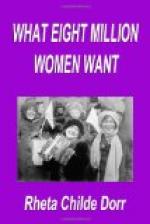The Supreme Court of the State of Illinois decided that the American Constitution was never intended to shield manufacturers in their willingness to poison women under pretense of giving them work. The ten-hour law was sustained.
That the “Girls’ Bill” passed, or that it was even introduced, was due in large measure to an organization of women, more militant and more democratic than any other in the United States. This is the Women’s Trade Union League. Formed in New York about seven years ago, the League consists of women members of labor unions, a few men in organized trades, and many women outside the ranks of wage earners. Some of these latter are women of wealth, who are believers in the trade-union principle, but more are women who work in the professional ranks,—teachers, lawyers, physicians, writers, artists, settlement workers. These are the first professional workers, men or women, who ever asked for and were given affiliation with the American Federation of Labor. They are the first people, outside the ranks of wage earners, to appear in Labor Day parades.
The object of the League, which now has branches in five cities,—New York, Boston, Chicago, St. Louis, and Cleveland,—is to educate women wage earners in the doctrine of trade unionism. The League trains and supports organizers among all classes of workers. As quickly as a group in any trade seems ready for organizing the League helps them. It raises funds to assist women in their trade struggles. It acts as arbitrator between employer and wage earners in case of shop disputes.
The Women’s Tracle Union League reaches not only women in factory trades, but it has succeeded in organizing women who until lately believed themselves to be a grade above this social level. One hundred and fifty dressmakers in New York City belong to a union. Seventy stenographers have organized in the same city. The Teachers’ Federation of Chicago is a labor union, and although it was formed before the Women’s Trade Union League came into existence, it is now affiliated. The women telegraphers all over the United States are well organized.
The businesslike, resourceful, and fearless policy of the League was brilliantly demonstrated during the famous strike of the shirt-waist makers in New York and Philadelphia in the winter of 1910. The story of this strike will bear retelling.
On the evening of November 22, 1909, there was a great mass meeting of workers held at Cooper Union in New York. Samuel Gompers, President of the American Federation of Labor, presided, and the stage was well filled with members of the Women’s Trade Union League. The meeting had been called by the League in conjunction with Shirt-Waist Makers’ Union, Local 25, to consider the grievances of shirt-waist makers in general, and especially of the shirt-waist makers in the Triangle factory, who had been, for more than two months, on strike.
The story of the strike, the causes that led up to it, and the bitter injustice which followed it were rehearsed in a dozen speeches. It was shown that for four to five dollars a week the girl shirt-waist makers worked from eight in the morning until half-past five in the evening two days in the week; from eight in the morning until nine at night four days in the week; and from eight in the morning until noon one day in the week—Sunday.




